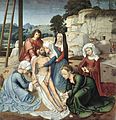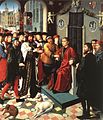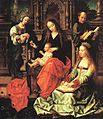- Gerard David
-
Gerard David 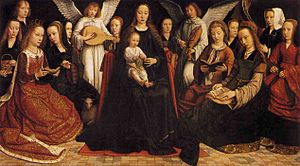
The Virgin among angels (1509)
A self portrait of Gerard David on the top left corner
Musée des Beaux-Arts, RouenBorn c. 1460
OudewaterDied 13 August 1523 Nationality Netherlandish Field Painting Movement Early Netherlandish painting Gerard David (c. 1460 – 13 August 1523) was an Early Netherlandish painter and manuscript illuminator known for his brilliant use of color.
Contents
Life
He was born in Oudewater, now located in Utrecht. He spent his mature career in Bruges, where he was a member of the painters' guild. Upon the death of Hans Memling in 1494, David became Bruges' leading painter.
David had been completely forgotten when in the early 1860s he was rescued from oblivion by William Henry James Weale, whose researches in the archives of Bruges brought to light the main facts of the painter's life and led to the reconstruction of David's artistic personality, beginning with the recognition of David's only documented work, the Virgin Among Virgins at Rouen.[1] There is now documentary evidence for the following: that David came to Bruges in 1483, presumably from Haarlem, where he had formed his early style under Albert van Oudewater; he joined the guild of St Luke at Bruges in 1484 and became dean of the guild in 1501; in 1496 he married Cornelia Cnoop, daughter of the dean of the goldsmiths' guild; he became one of the town's leading citizens; he died on 13 August 1523 and was buried in the Church of Our Lady at Bruges.[2]
Work
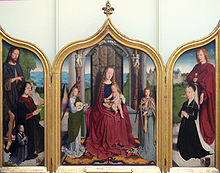 Gerard David's Triptych of the Sedano family, 1523, an example of Oriental carpets in Renaissance painting. Louvre Museum.
Gerard David's Triptych of the Sedano family, 1523, an example of Oriental carpets in Renaissance painting. Louvre Museum.
In his early work, David had followed Haarlem artists such as Dirk Bouts, Albert van Oudewater and Geertgen tot Sint Jans, though he had already given evidence of superior power as a colourist. To this early period belong the St John of the Kaufmann collection in Berlin and the Saltings St Jerome. In Bruges he studied and copied masterpieces by the Van Eycks, Rogier van der Weyden and Hugo van der Goes. Here he came directly under the influence of Memling, the master whom he followed most closely. It was from him that David acquired a solemnity of treatment, greater realism in the rendering of human form, and an orderly arrangement of figures.
Another master was to influence him later in life, when in 1515 he visited Antwerp and was impressed with the work of Quentin Matsys, who had introduced a greater vitality and intimacy in the conception of sacred themes. David's Pietà in the National Gallery, London, and the Descent from the Cross in the Cavallo collection Paris (Guildhall, 1906), were painted under this influence and are remarkable for their sense of dramatic movement. But the works on which David's fame has rested most securely are the great altarpieces he painted before his visit to Antwerp: the Marriage of St Catherine, at the National Gallery, London; the triptych of the Madonna Enthroned and Saints of the Brignole-Sale collection in Genoa; the Annunciation of the Sigmaringen collection; and above all, the Madonna with Angels and Saints, which he painted without asking a fee from the Carmelite Nuns of Sion[disambiguation needed
 ] at Bruges, and which is now in the Rouen museum.
] at Bruges, and which is now in the Rouen museum.Only a few of his works have remained in Bruges: The Judgment of Cambyses, The Flaying of Sisamnes and the Baptism of Christ in the Groeningemuseum, and the Transfiguration in the Church of Our Lady. The rest were scattered around the world, and to this may be due the oblivion into which his very name had fallen; this, and the fact that, for all the beauty and the soulfulness of his work, he had nothing innovative to add to the history of art. Even in his best work he had only given newer variations of the art of his predecessors and contemporaries. His rank among the masters was renewed, however, when a considerable number of his paintings were assembled at Bruges for a 1902 exhibition of the early Flemish painters.
He also worked closely with the leading manuscript illuminators of the day, and seems to have been brought in to paint specific important miniatures himself, among them a Virgin among virgins in the Morgan Library, and a portrait of the Emperor Maximilian in Vienna. Several of his drawings also survive, and elements from these appear in the works of other painters and illuminators for several decades after his death.[3]
Legacy
At the time of David's death, the glory of Bruges and its painters was on the wane: Antwerp had become the leader in art as well as in political and commercial importance. Of David's pupils in Bruges, only Isenbrant, Albert Cornelis and Ambrosius Benson achieved importance. Among other Flemish painters, Joachim Patinir and Jan Mabuse were to some degree influenced by him.
Eberhard Freiherr von Bodenhausen published in 1905 a very comprehensive monograph on Gerard David and his School (Munich, F. Bruckmann), together with a catalogue raisonné of his works, which, after careful analysis, are reduced to a total of forty-three paintings.
-
Our Lady of the Fly, attributed to Gerard David and/or someone of the circle of Jan Mabuse, c. 1520; Isabella I of Castile is featured to the lower right, in a green dress.
References
- ^ Weale, Gerard David, Painter and Illuminator 1895; the Virgo inter Virgines appears in a 1527 inventory of the Carmelite convent of Sion at Bruges.
- ^ Additional documents were presented by Hans J. van Miegroet, "New Documents Concerning Gerard David" The Art Bulletin 69.1 (March 1987:33-44).
- ^ T. Kren & S. McKendrick (eds), Illuminating the Renaissance - The Triumph of Flemish Manuscript Painting in Europe, Getty Museum/Royal Academy of Arts, pp. 344-365, 2003, ISBN 19033973287
Sources
 This article incorporates text from a publication now in the public domain: Chisholm, Hugh, ed (1911). Encyclopædia Britannica (11th ed.). Cambridge University Press.
This article incorporates text from a publication now in the public domain: Chisholm, Hugh, ed (1911). Encyclopædia Britannica (11th ed.). Cambridge University Press. This article incorporates text from a publication now in the public domain: Herbermann, Charles, ed (1913). "Gheeraert David". Catholic Encyclopedia. Robert Appleton Company.
This article incorporates text from a publication now in the public domain: Herbermann, Charles, ed (1913). "Gheeraert David". Catholic Encyclopedia. Robert Appleton Company.
External links
Categories:- 1460s births
- 1523 deaths
- Dutch painters
- Early Netherlandish painters
- Flemish painters
- Manuscript illuminators
- Members of the Bruges Guild of Saint Luke
- People from Oudewater
Wikimedia Foundation. 2010.


